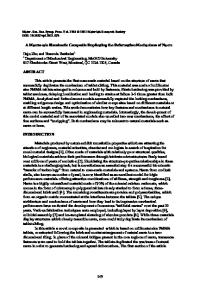Deformation mechanisms in nacre
- PDF / 1,027,483 Bytes
- 9 Pages / 612 x 792 pts (letter) Page_size
- 74 Downloads / 427 Views
Z. Suo and A.G. Evans Department of Mechanical and Aerospace Engineering and Princeton Materials Institute, Princeton University, Princeton, New Jersey 08544
N. Yao Princeton Materials Institute, Princeton University, Princeton, New Jersey 08544
I.A. Aksay Department of Chemical Engineering and Princeton Materials Institute, Princeton University, Princeton, New Jersey 08544 (Received 27 December 2000; accepted 4 June 2001)
Nacre (mother-of-pearl) from mollusc shells is a biologically formed lamellar ceramic. The inelastic deformation of this material has been experimentally examined, with a focus on understanding the underlying mechanisms. Slip along the lamellae tablet interface has been ascertained by testing in compression with the boundaries oriented at 45° to the loading axis. The steady-state shear resistance ss has been determined and inelastic strain shown to be as high as 8%. The inelastic deformation was realized by massive interlamellae shearing. Testing in tension parallel to the tablets indicates inelastic strain of about 1%, occurring at a steady-state stress, ss ≈ 110 MPa. The strain was associated with the formation of multiple dilatation bands at the intertablet boundaries accompanied by interlamellae sliding. Nano-asperities on the aragonite tablets and their interposing topology provide the resistance to interfacial sliding and establish the level of the stress needed to attain the inelastic strain. Detailed mechanisms and their significance for the design of robust ceramics are discussed.
I. INTRODUCTION
Some biological materials exhibit structural robustness, despite the brittle nature of their constituents. Well known examples include bone, teeth, and mollusc shells.1–3 Nacre (mother-of-pearl), the pearly internal layer of many mollusc shells, is addressed in this study. This material comprises about 95% aragonite (a mineral form of CaCO3), with only a few percent of biological macromolecules: yet its work of fracture is about 3 orders of magnitude higher than monolithic ceramics,4,5 and its strength is among the highest in shell structures.6 A thorough understanding of the mechanisms underlying this robustness could inspire new ideas in material design and synthesis. The goal of this study, in conjunction with a companion theoretical analysis,7 is to elucidate the basic mechanisms. As elaborated elsewhere,8,9 good toughness is a necessary but not sufficient requirement for structural utility. The more basic prerequisite is a deformation mechanism that permits the material to exhibit inelastic strain when loaded in tension and shear. The basic idea is that (when sufficiently large, relative to elastic strains) J. Mater. Res., Vol. 16, No. 9, Sep 2001
http://journals.cambridge.org
Downloaded: 14 Jan 2015
this inelastic deformation allows the material to redistribute stress around strain concentration sites, thereby eliminating stress concentrations and, consequently, rendering the material “notch insensitive.”8,9 Absent this strain capacity, materials are susceptible to unpredictable
Data Loading...











